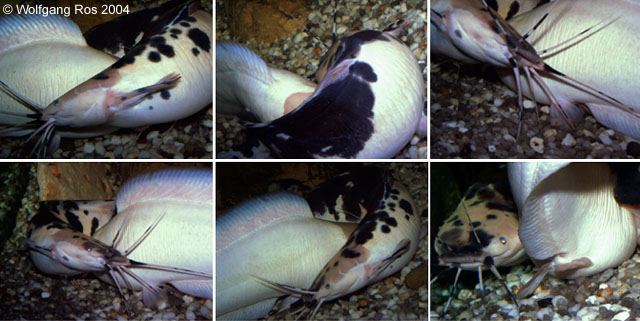Clarias
batrachus
(Linnaeus,
1758)
Philippine catfish
View all media / Upload your photos and videos
Expand all
Classification / Names
Teleostei (teleosts) > Siluriformes (Catfishes) >
Clariidae (Airbreathing catfishes)
Etymology: Clarias: Greek, chlaros = lively, in reference to the ability of the fish to live for a long time out of water
More on author:
Linnaeus.
Environment / milieu / depth range / climate zone / distribution range
Distribution
Asia: Java, Indonesia. Clarias aff. batrachus from Indochina and Clarias aff. batrachus from Sundaland have been misidentified as Clarias batrachus from Java. Introduced elsewhere. Several countries report adverse ecological impact after introduction.
Length at first maturity / Size / Weight / Age
Short description
Dorsal spines (total): 0; Dorsal soft rays (total): 60 - 76; Anal spines: 0; Anal soft rays: 47 - 58. Body compressed posteriorly. Upper jaw a little projecting. Spine of pectoral fins rough on its outer edge and serrated on its inner edge (Ref. 4792). Occipital process more or less triangular, its length about 2 time in its width (Ref. 27732); distance between dorsal and occipital process 4-5.5 times in distance from tip of snout to end of occipital process (Ref. 43281). Genital papilla in males is elongated and pointed (Ref. 52012).
Biology
Adults inhabit lowland streams (Ref. 57235), swamps, ponds, ditches, rice paddies, and pools left in low spots after rivers have been in flood (Ref. 2854, 57235). Usually confined to stagnant, muddy water (Ref. 1479). Found in medium to large-sized rivers, flooded fields and stagnant water bodies including sluggish flowing canals (Ref. 12975). Undertake lateral migrations from the Mekong mainstream, or other permanent water bodies, to flooded areas during the flood season and returns to the permanent water bodies at the onset of the dry season (Ref. 37770). Can live out of water for quite sometime and move short distances over land (Ref. 4833). Can walk and leave the water to migrate to other water bodies using its auxiliary breathing organs. The Lao use this fish as lap pa or ponne pa. Feed on insect larvae, earthworms, shells, shrimps, small fish, aquatic plants and debris (Ref. 6459). An important food fish (Ref. 4833) that is marketed live, fresh and frozen (Ref. 9987). Recently rare, being replaced by introduced African walking catfish (Ref. 57235).
Life cycle and mating behavior
The pair manifests the 'spawning embrace' which is widely observed in other catfish species (Ref. 33313). The pair gently nudge each other in the genital region and flick their dorsal fins; male wraps his body around the female, then the female releases a stream of adhesive eggs into the nest (Ref. 44091). In southeast Asia, spawning period is during the rainy season, when rivers rise and fish are able to excavate nests in submerged mud banks and dikes of flooded rice fields (Ref. 40977).
Main reference
Rahman, A.K.A. 1989 Freshwater fishes of Bangladesh. Zoological Society of Bangladesh. Department of Zoology, University of Dhaka. 364 p. (Ref. 1479)
IUCN Red List Status (Ref. 125652)
Least Concern (LC); date assessed: January 16 2019
CITES (Ref. 131153)
Not Evaluated
CMS (Ref. 116361)
Not Evaluated
Threat to humans
Potential pest (Ref. 4690)
More information
- Countries
- FAO areas
- Ecosystems
- Occurrences
- Introductions
- Stocks
- Ecology
- Diet
- Food items
- Food consumption
- Ration
- Common names
- Synonyms
- Metabolism
- Predators
- Ecotoxicology
- Reproduction
- Maturity
- Spawning
- Spawning aggregation
- Fecundity
- Eggs
- Egg development
- Age/Size
- Growth
- Length-weight
- Length-length
- Length-frequencies
- Morphometrics
- Morphology
- Larvae
- Larval dynamics
- Recruitment
- Abundance
- References
- Aquaculture
- Aquaculture profile
- Strains
- Genetics
- Allele frequencies
- Heritability
- Diseases
- Processing
- Mass conversion
- Vision
- Pictures
- Stamps, Coins Misc.
- Sounds
- Ciguatera
- Speed
- Swim. type
- Gill area
- Otoliths
- Brains
Estimates based on models
Phylogenetic diversity index (Ref. 82804): PD50 = 0.5 [Uniqueness, from 0.5 = low to 2.0 = high].
Bayesian length-weight: a=0.00912 (0.00727 - 0.01144), b=2.95 (2.90 - 3.00), in cm total length, based on LWR estimates for this species (Ref. 93245).
Trophic level (Ref. 69278): 3.4 ±0.5 se; Based on food items.
Generation time: 1.5 ( na - na) years. Estimated as median ln(3)/K based on 1 growth studies.
Resilience (Ref. 120179): High, minimum population doubling time less than 15 months (K=0.7 (in aquarium); tm=1; Fec=2,300-13,400).
Fishing vulnerability (Ref. 59153): Low vulnerability (24 of 100).
Price category (Ref. 80766): Unknown.
Nutrients (Ref. 124155): Calcium = 45.2 [22.7, 201.2] mg/100g; Iron = 1.32 [0.83, 2.29] mg/100g; Protein = 16.7 [15.8, 17.7] %; Omega3 = 0.134 [0.067, 0.288] g/100g; Selenium = 95.9 [41.2, 218.7] μg/100g; VitaminA = 13.6 [5.6, 33.8] μg/100g; Zinc = 0.766 [0.567, 1.018] mg/100g (wet weight); based on nutrient studies.










